when little is big
keith gallasch: 2011 sydney festival
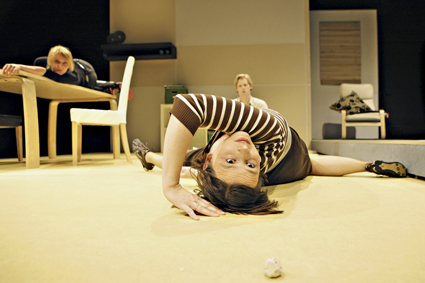
Good Cop Bad Cop, Kassys
photo Prudence Upton
Good Cop Bad Cop, Kassys
MAJOR ARTS FESTIVALS LIKE TO THINK BIG, PROGRAMMING A HANDFUL OF BIG WINNERS (WELL RUN-IN BY OTHER INTERNATIONAL FESTIVALS), ONE OR TWO OTHER WORKS OF SCALE (RELIABLE BRAND NAMES, RELATIVELY LOW RISK) AND A BIG RETINUE OF SMALL SHOWS. NOWADAYS ADD TO THIS A BIG SCHEDULE OF SOLO SINGERS AND BANDS AND OTHER ENTERTAINMENTS THAT CO-EXIST WITH THE FESTIVAL IF APPEARING TO HAVE LITTLE TO DO WITH THE ARTISTIC DIRECTOR’S VISION. THESE LARGELY PLAY TO A VERY DIFFERENT AUDIENCE, BUT PRESUMABLY PROVIDE GUARANTEED INCOME. THE 2011 SYDNEY FESTIVAL WAS AN OCCASION WHEN SOME BIG SHOWS DIDN’T COME GOOD AND LITTLE WAS BIG—THE PROGRAM’S SMALL-SCALE WORKS, TO VARYING DEGREES, OFFERING INNOVATION, PROVOCATION AND ENGAGEMENT.
The Netherlands company Kassy’s Good Cop Bad Cop snuck up on me. Here was an immaculate domestic setting, ideal for a sitcom or a David Williamson play, with three casually attired performers loitering onstage pre-show and occasionally striking unusual poses while staring intently at nothing in particular. What unfolds is a gentle fable-cum-soap opera about the lives and loves of domestic animals, acutely observed, cleverly avoiding standard mimicry (the actors dropping in and out of animality) and complemented with an onscreen commentary from the characters in a more human vein, but never too complicated so that the human-animal divide is constantly erased. Instead of anthropomorphism we’re offered a comic vision that looks both ways—distancing us from animal behaviour, to regard it anew, while pointing up our need to project intention onto animals and simultaneously confirming our own animal-ness. Beautifully paced and performed with loving attention to detail, Good Cop Bad Cop was a welcome surprise.
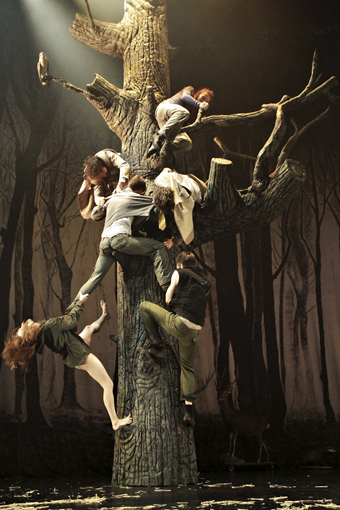
Food Chain, Animal Farm Collective
photo Prudence Upton
Food Chain, Animal Farm Collective
Animal life, human and other, was also the subject of Gavin Webber and Grayson Millwood’s Food Chain, a larger scale work with bigger ambitions. A huge tree, reaching up beyond the proscenium fills centrestage, immaculately ‘sculpted’ it appears at once real and false as does the world around it, transmuting from forest to museum diorama and back again and then, nightmarishly, into one. A pair of apparently taxidermied bears come to life and terrorise a pair of campers—she is eaten, he is wounded when the increasingly human bears shoot him—and a female museum attendant who, in projected shadow play on the wall of a tent, has sex with one of the bears. Subsequently, Salome-like, she dances with his head. In this fantastical world, the bears chat about human behaviour like smutty armchair zoologists, use the scent of their female victim to attract her wounded partner and transform into moustachioed, beige-suited, but no less violent men. The outsider in the scenario is a tree-dwelling man in a bad monkey suit who, leaving his isolation, lectures the smaller forest animals on how to deal with bears but veers wildly instead into how to accept your fate in their jaws—prefiguring his own subsequent demise.
While the bear behaviour is nicely executed and the stage design is embracing, the structure of Food Chain is loose, the pacing sluggish and the comic neo-Darwinian tooth and claw savagery taxing. Redemption comes in a beautiful and unexpected coda as the entire cast form a positive version of the chain of animal life, one of mutuality. This is the descent of species in which cooperation is vital and eternal: singly and then wondrously linked the performers perpetually lower themselves down the tree, disappearing ever so briefly behind it only to appear again at its top with the most subtle directorial sleight of hand.
Gob Squad’s much anticipated Super Night Shot also adopted animal guises, in the form of cheap masks as four performers ventured into the world immediately around the Sydney Opera House, each with a camera, to make a quickie movie in an hour which was then immediately shown unedited and sound-mixed live for us on four large screens. At the centre of a highly synchronised venture was the chance outcome of approaching strangers to find one who would kiss the performer wearing a rabbit mask. The resultant blend of technological assuredness and the happenstance of improvisation was engaging, and quite free of profundities. The work simply celebrated DIY spontaneity, technologically and performatively, with a Live Art back-to-basics vision challenging the sophistication and complexity of the big end of the entertainment world.
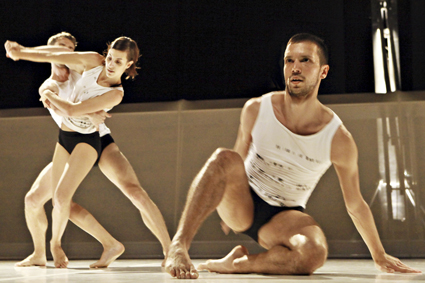
Entity, Random Dance
photo Prudence Upton
Entity, Random Dance
Wayne McGregor’s Entity is a large-scale work that also uses screens, three big, wide ones framing the dance space and mounted on mechanical devices that dancers could raise or lower by hand as required. Onto these were projected equations and data scrolling furiously if dimly. The dancing was also furious—fast and acutely articulated, balletic but constantly and miraculously off-centre in the Forsythe manner. Striking solos and duets with odd holds and sudden acrobatic inversions or rare slow unfoldings multiplied virally across the stage until the mass of dancers dissolved and a new set was initiated. I was seduced moment by moment but the sense of a totality evaded me.
McGregor’s fascination with the science and psychology of the creative process makes for good reading but the subject is not convincingly embodied in Entity: “By forcing breakdowns of coordination in his dancers, McGregor hoped to gain an insight into the relationship between their physical and cognitive functions. To this end he submitted the dancers to perturbations, assigning them tasks like counting backwards while dancing, and making them wear prisms over their eyes to distort their spatial awareness” (Luke Jennings, program note). Certainly the dancers evinced a remarkable certainty of purpose against the odds of speed and complicated shaping but Entity’s rhythmic sameness (countered somewhat by the melancholy string score of the first section but underlined by the driven pop pulse of the second), the iterated theme and variation structure and the vapidity of the screen deployment gravitated against coherence and interest. The relationship between dancers and projections was nil, the raising and lowering of screens insignificant—a prime example of ‘background new media.’ Australian artists Gideon Obarzanek, Lucy Guerin and Garry Stewart integrate dancers and stage materials, whether objects, projections or devices, with thoroughness and creativity.
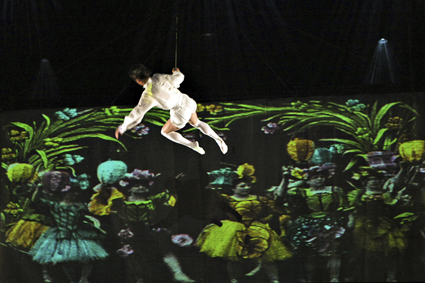
Alexandra Harrison, My Bicycle Loves You, Legs on the Wall
photo Prudence Upton
Alexandra Harrison, My Bicycle Loves You, Legs on the Wall
More projections came in the form of wonderful footage from the Australian National Film and Sound Archive from the early 20th century Corrick family circus that showed film—beautiful, funny, strange—as part of their repertoire, 1901-14. Whether or not this was just value adding or seminal multimedia work is not clear, but despite attempts by Legs on the Wall to connect stage action with film image, My Bicycle Loves You was not a convincing merger of live bodies and projections. This was partly a problem of scale, the images sometimes huge, filling the stage as a superfluity of screens flew in and out. At other times the correspondence, at human scale, was right, with a ghostly suggestiveness. But the production’s problems were not simply to do with a disjuncture between body and image but with a chasm between the past and now, between contemporary characters and their mysterious antecedents. There are moments when those in the present watch the past, but the connections are thin, as are the relationships between the seven characters in the contemporary setting, an apartment block where their lives intersect, each person with a problem or a fantasy life that remains largely unexplored. As physical theatre, My Bicycle Loves You was unusually tame for a company like Legs on the Wall, and the relationship between routine-based scenes and the overall scenario often seemed tenuous. The show had its physical high points (not least from Alexandra Harrison and Tom Flanagan) and a great band led by Ben Walsh, but its structural disjuncts were too large to accommodate its ambitions.
Bigger Than Jesus, written and performed by Canadian artist Rick Miller was a minor festival highlight, a bit like Richard Dawkins doing his atheism number as stand-up. Mixing forms (comedian, lecturer, preacher) and media (live video, rough puppetry, superimposed stage and screen images), Miller vented his hostility to organised religion with glee (the demotic Blakean preacher being the best of it) and cunning (an hilarious Last Supper featuring among the guests a John Lennon doll and a Homer Simpson PEZ dispenser as Judas). In the end it’s clear that Miller is not only fond of Jesus but in a curiously narcissistic finale becomes physically one with a projected painting (Dali I think) of his crucified other. With the debates over atheism, religious belief and fundamentalism still raging, Bigger Than Jesus is a timely entertainment if sagging mid-way in its jet flight to Jerusalem routine and in the datedness of some of its screen technology.
The less said about the festival’s big ticket show, The Giacomo Variations, the better. An underdeveloped, clunky cut and paste life of Casanova interpolated with occasionally apposite songs from various Mozart operas, it featured a very good soprano and a fine tenor (both required to do extraordinary physical acts while singing—usually of a sexual variety), an adequate actress and the Sydney Symphony Orchestra sounding fine. John Malkovich as Casanova meandered through the narrative with none of the brisk, varied delivery of his long-ago Dangerous Liaisons movie performance as a similar rake. It was indeed strange not to have a festival with a centrepiece (as awkward as that concept can be) like the Hamlet or the Wars of the Roses of recent Sydney Festivals.
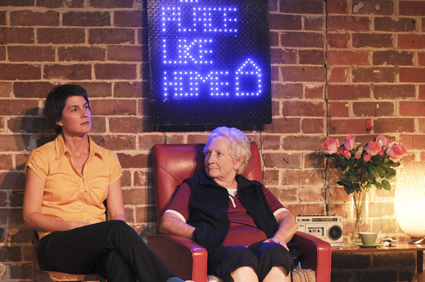
Rosie Dennis, June Hickey, Driven to New Pastures
photo Heidrun Löhr
Rosie Dennis, June Hickey, Driven to New Pastures
At the very small end of the festival spectrum was Rosie Dennis’ Driven to New Pastures, a subtle exploration of the impact of commercial residential developments on public housing in the suburbs. Except for its opening, where Dennis adeptly delivers a clever cliche-saturated sales pitch for a new nature free, maximum privacy and security development, protest is avoided. Instead Dennis recounts the events that will shift an older woman out of her home and into isolation. She is joined onstage by June Hickey, from Minto in outer Sydney, playing someone like herself who has been faced with this prospect (if with a different outcome from the one reported on stage). Hickey has an easy presence, listens, reads, dances with Dennis and speaks a little—perhaps she should have shared some of Dennis’ words (it seems she didn’t want to memorise lines, but there are other means) to give the show a finer balance, a break from the sense of monologue. Dennis’ writing and its fine grained improvisational feel is as pleasurable as ever and the simple theatricality of the work—the turning on and off of lamps for example—is effective, if faltering a little in an atypical scene in which one of the building’s inhabitants stages a rocket escape from the plight of displacement. Driven to New Pastures is an admirable work; I would like to have seen it closer to home with the audience who first experienced it, in a church hall in Minto in 2010.
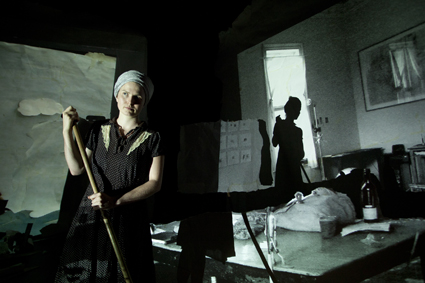
Fleur Elise Noble, 2 Dimensional Life of Her
photo Jamie Williams
Fleur Elise Noble, 2 Dimensional Life of Her
Returning to the subject of projections deployed in performance, Fleur Elise Noble’s 2 Dimensional Life of Her is a performative screen work par excellence. Huge sheets of paper swathe the intimate stage space onto which are projected a large living room in a couple of layers on one side and, before us, a black and white world of marionettes who appear to tear through the screens and finally set full-colour fire to the set. Noble arrives in the flesh (having hitherto functioned unseen as a puppet master or as a projected cleaning lady) to admonish her creations and send them off sailing. An essay on creativity, control, manipulation and ways of seeing, 2 Dimensional Life is witty, technically deft and engrossing, offering more dimensions than its bigger festival counterparts. Now, after its 2010 Mobile States tour and Sydney Festival appearance, it’s to travel to festivals around the world.
Sydney Festival 2011: Kassys, Good Cop Bad Cop, Seymour Centre Downstairs, Jan 26-30; Gavin Webber & Grayson Millwood, Animal Farm Collective, Food Chain, design Moritz Muller, Everest Theatre, Seymour Centre, Jan 26-30; Gob Squad, Super Night Shot, Studio, Sydney Opera House, Jan 25-30; Random Dance, Entity, concept, direction and choreography (with the dancers), design Patrick Burnier; Legs on the Wall, My Bicycle Loves You, story by Beatrix Christian, Patrick Nolan, Anna Tregloan and company, director Patrick Nolan, designer Anna Tregloan, projection consultant Tim Gruchy, Sydney Theatre, Jan 11-15; Bigger Than Jesus, performer Rick Miller, creators Rick Miller and director Daniel Brooks, Wharf 1, STC, Jan 18-29; The Giacomo Variations, writer, director Michael Sturminger, Concert Hall, Sydney Opera House, Jan 20-22; Driven to New Pastures, writer, performer Rosie Dennis, performer June Hickey, Downstairs, Seymour Centre, Jan 11-16; 2 Dimensional Life of Her, creator Fleur Elise Noble, Downstairs, Seymour Centre, Jan 9-13
RealTime issue #101 Feb-March 2011 pg. 14-15






